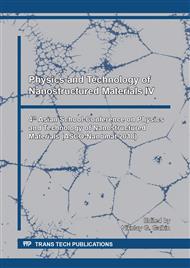[1]
Harald Rose, Geometrical Charged-Particle Optics, second ed., Springer-Verlag, Berlin Heidelberg, (2012).
Google Scholar
[2]
Advances in Imaging and Electron Physics: Aberration-Corrected Electron Microscopy, ed. by P.W. Hawkes, Elsevier, 153 (2008).
Google Scholar
[3]
B.N. Grudin et al., Simulation and analysis of images using spectral characteristics, Bull. Rus. Acad. Sci.: Phys. 76 (2012) 1020-1024.
Google Scholar
[4]
S. Jonić et al., A novel method for improvement of visualization of power spectra for sorting cryo-electron micrographs and their local areas, J Struct Biol. 157 (2007) 156-167.
DOI: 10.1016/j.jsb.2006.06.014
Google Scholar
[5]
G. McMullan, K.R. Vinothkumar, R. Henderson, Thon rings from amorphous ice and implications of beam-induced Brownian motion in single particle electron cryo-microscopy, Ultramic. 158 (2015) 26-32.
DOI: 10.1016/j.ultramic.2015.05.017
Google Scholar
[6]
A. Rohou, N. Grigorieff CTFFIND4: Fast and accurate defocus estimation from electron micrographs, J Struct. Biol. 192 (2015) 216-221.
DOI: 10.1101/020917
Google Scholar
[7]
R. Yan et al., A fast cross-validation method for alignment of electron tomography images based on Beer-Lambert law, J Struct Biol. 192 (2015) 297-306.
DOI: 10.1016/j.jsb.2015.10.004
Google Scholar
[8]
C. L. Jia, M. Lentzen, K. Urban, Atomic-Resolution Imaging of Oxygen in Perovskite Ceramics, Sci. 299 (2003) 870.
DOI: 10.1126/science.1079121
Google Scholar
[9]
K. Kimoto et al., Quantitative evaluation of temporal partial coherence using 3D Fourier transforms of through-focus TEM images, Ultramic. 134 (2013) 86.
DOI: 10.1016/j.ultramic.2013.06.008
Google Scholar
[10]
E. J. Kirkland, Advanced computing in electron microscopy, second ed., Springer, USA (2010).
Google Scholar
[11]
J. C. H. Spence, High-Resolution Electron Microscopy, 4th ed., Oxford University Press, (2013).
Google Scholar
[12]
C.J. Russo, R. Henderson Microscopic charge fluctuations cause minimal contrast loss in cryoEM, Ultramic. 187 (2018) 56-63.
DOI: 10.1016/j.ultramic.2018.01.011
Google Scholar
[13]
E.B. Modin et al., Atomic structure and crystallization processes of amorphous (Co,Ni)-P metallic alloy, J. Alloy. Comp. 641 (2015) 139-143.
DOI: 10.1016/j.jallcom.2015.04.060
Google Scholar
[14]
E.V. Pustovalov et al., Structure relaxation and crystallization of the CoW-CoNiW-NiW electrodeposited alloys, Nanoscale Res. Lett. 9 (2014) 1-8.
DOI: 10.1186/1556-276x-9-66
Google Scholar
[15]
E.V. Pustovalov et al. Electron microscopy image simulation by GPU, Patent registration 2012616377 from 12 July 2012 (rus).
Google Scholar


